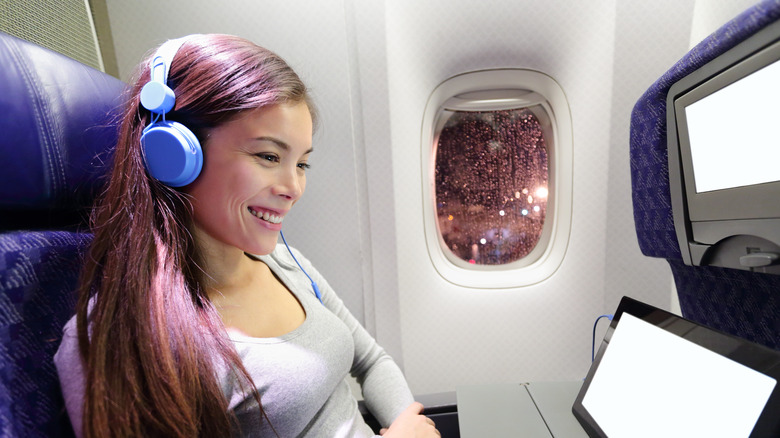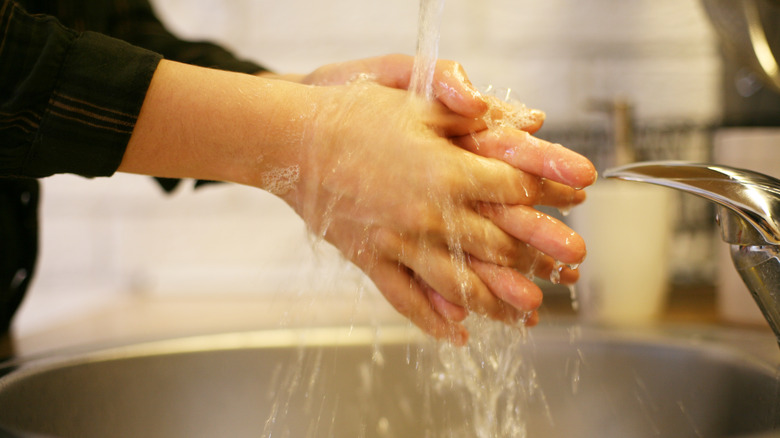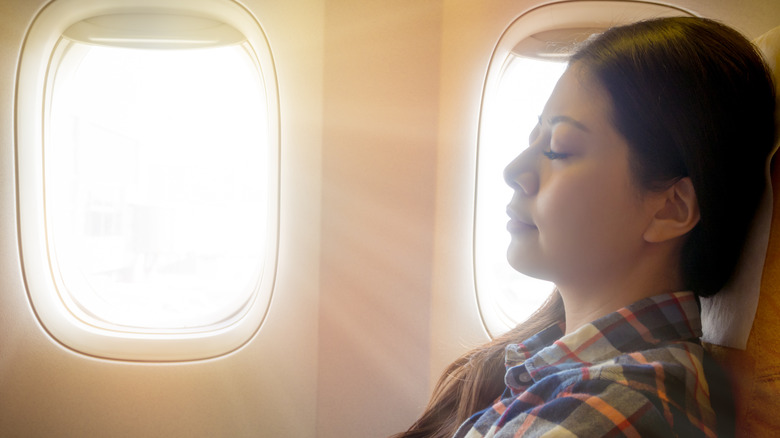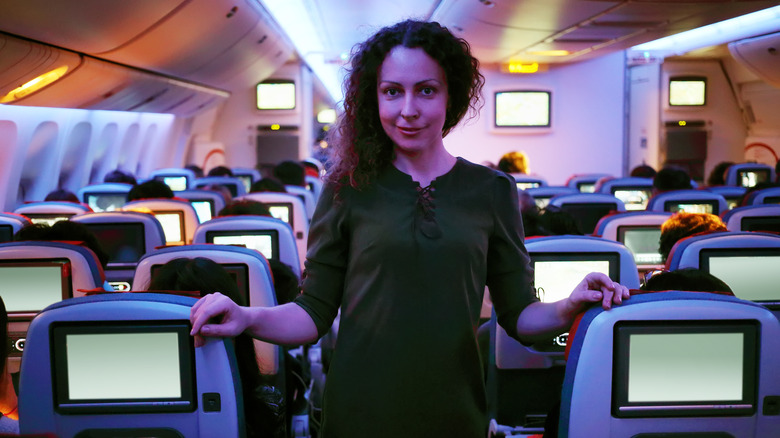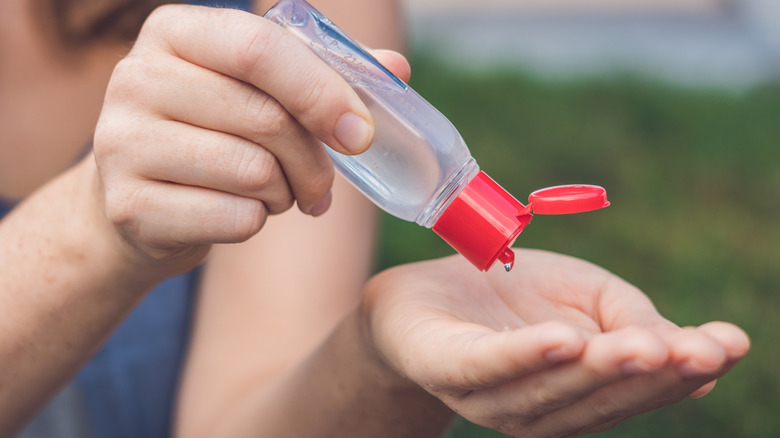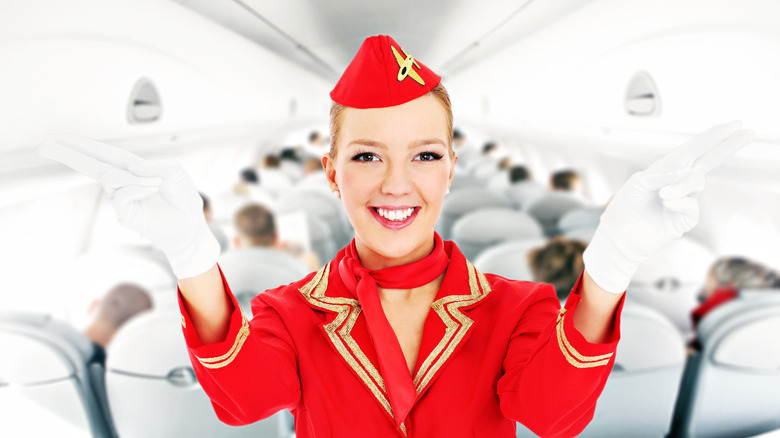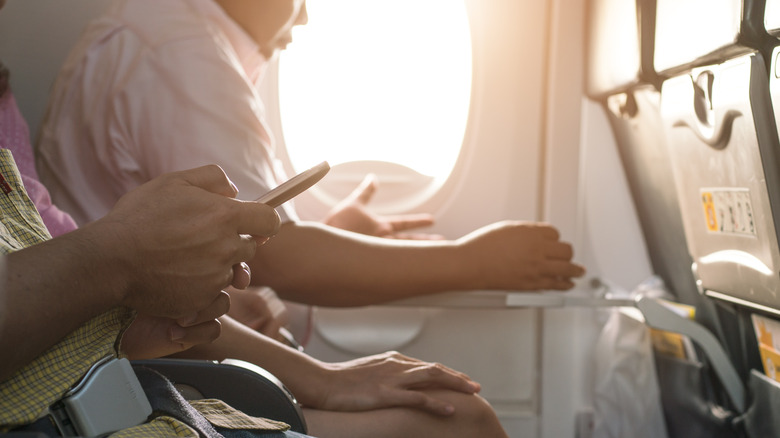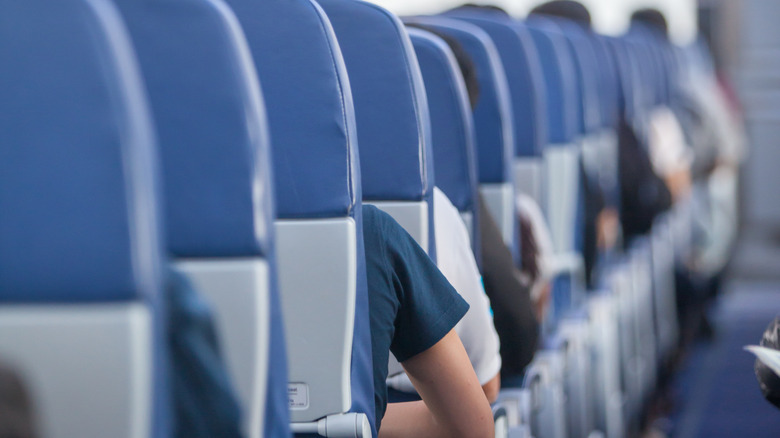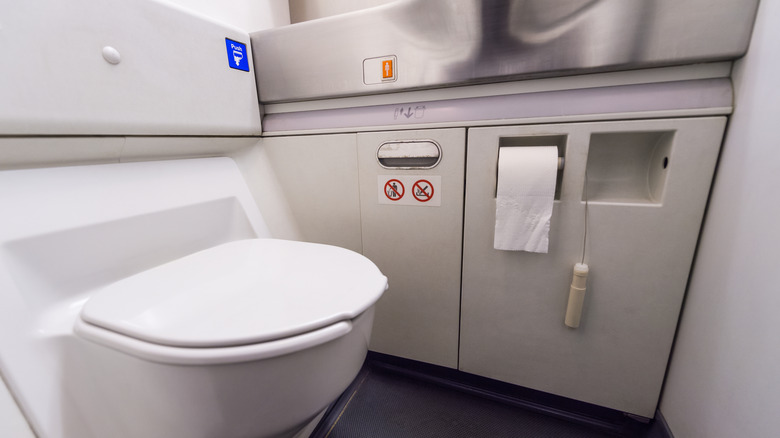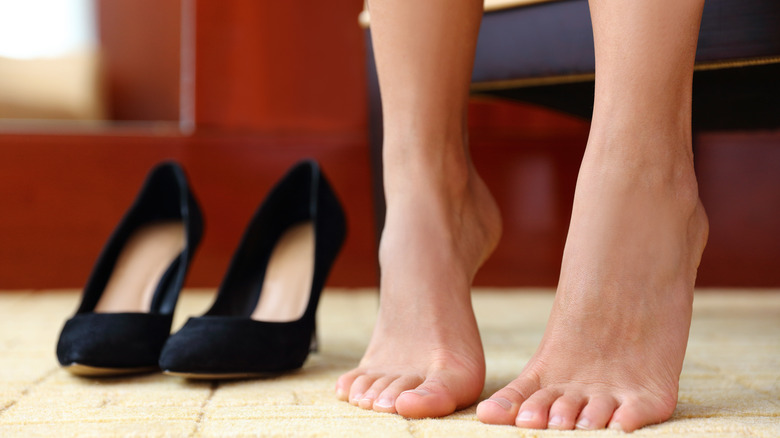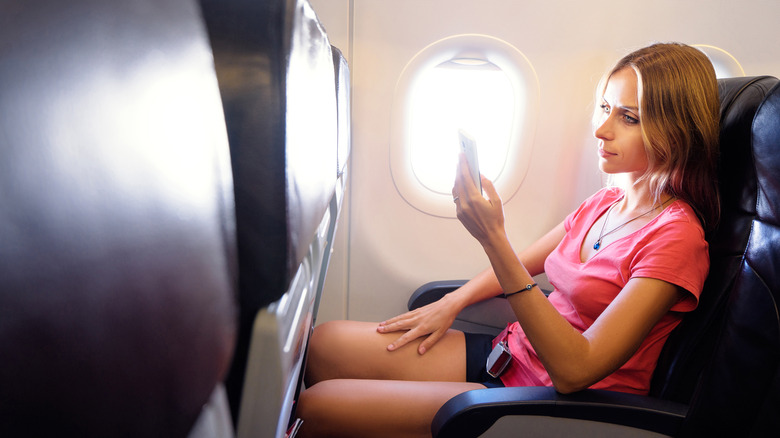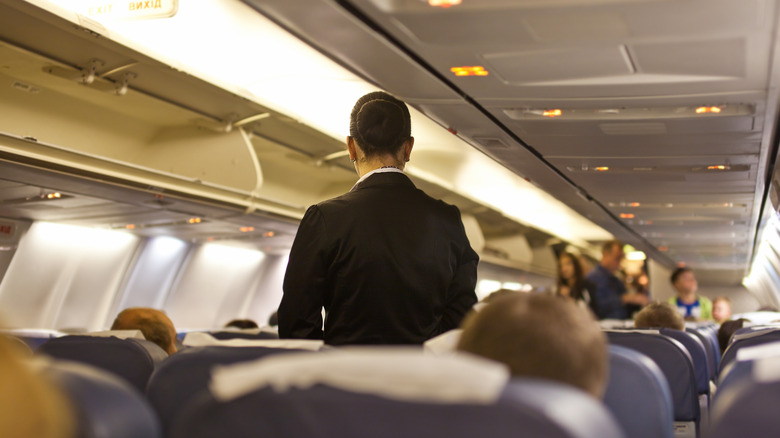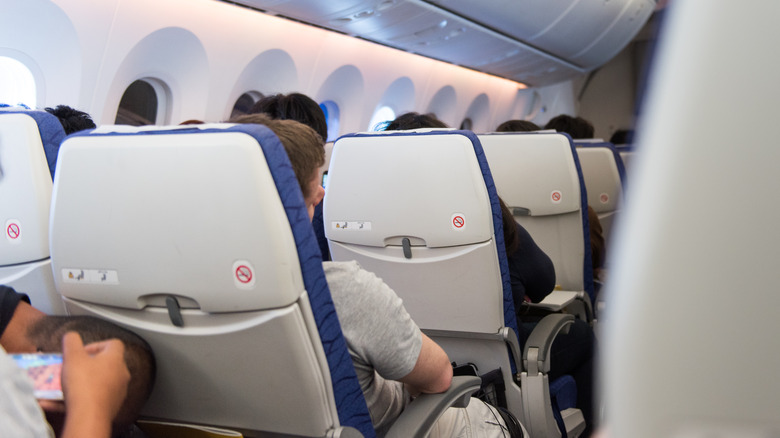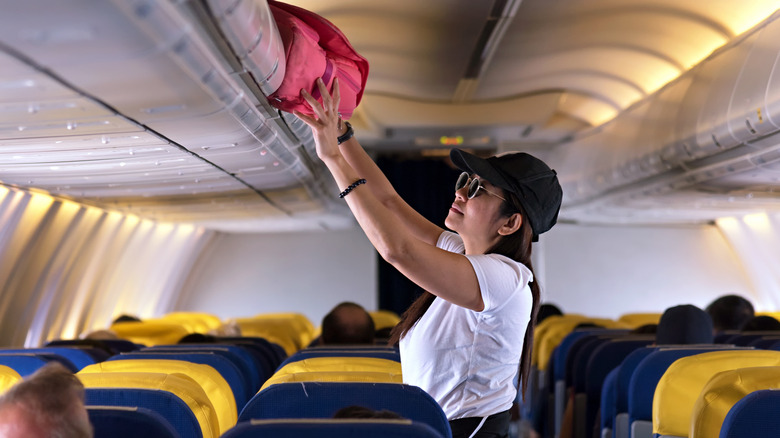7 Things You Should Never Do On An Airplane
Whether you are an avid traveler, do it regularly for business purposes, or participate out of necessity to visit friends or family in other parts of the country or world, there are certain things that every traveler needs to know.
You can study the TSA website top to bottom to learn what you can and can't bring on a plane, but those guidelines don't necessarily cover all of the countless other must-dos and don'ts when it comes to traveling by plane. Luckily, I consulted with a variety of doctors, physical therapists, and travel experts to point out the necessities we may otherwise overlook.
Always wash your hands
While it may seem obvious, it's important to point out the need to constantly be washing your hands while traveling, especially when navigating your way through the busy and packed airport and on board the aircraft.
Pulmonologist and author of Cough Cures, Dr. Gustavo Ferrer told me, "Hand washing is like a 'do-it-yourself' vaccine — it involves five simple and effective steps (wet, lather, scrub, rinse, dry) you can take to reduce the spread of respiratory illness so you can stay healthy."
He went on to add how regularly washing your hands is one of the best ways to remove germs, avoid getting sick, and prevent spreading germs to those around you. "Hand washing is a win for everyone, except the germs," he said.
Do perform exercises while seated
If you have ever flown on a plane, then you know it doesn't take long before you start to get a little antsy and uncomfortable in your seat. I constantly find myself fidgeting and adjusting my body in new ways to try and get a bit more comfortable.
It turns out, a little movement in your seat isn't a bad thing and according to the owner and Clinical Director of ActiveCare Physical Therapy in NYC, Dr. Karena Wu, we should actually be getting in a little exercise while we sit.
"Moving while sitting on the plane forces you to contract and relax your muscles so that any fluids do not get stagnant and gives you a little exercise at the same time," Wu told me. "Exercises like ankle circles/pumps, knee extension (straightening the knees), glute squeezes (squeezing your butt cheeks together) can help pump the muscles and give them a little workout at the same time." She suggests holding the movement for at least ten seconds to really feel that mini-workout component.
Always get up and walk around
If you are like me, then when given the opportunity, you choose to sit next to the window so you don't have to worry about getting up for the whole of the flight unless nature calls. It turns out, staying seated for the whole flight is not the best choice to make while traveling.
Dr. Wu suggests getting up and walking around the plane when you can, as sitting for long periods can be tough on our backs. She suggests stretching the quads by bending the foot back to the butt and then stretching the calves by standing one foot in front of the other and feeling the stretch in the back of the lower leg. Either of these stretches can be done while you wait in line for the bathroom or right in the aisle outside of your seat.
Sanitize, sanitize, sanitize!
I don't think there is any question that with so many people packed on one small plane, there will be a countless number of bacteria and viruses that we may exposed. Co-founder and Medical Director of IVme Wellness + Performance of Chicago, Dr. Jack Dybis said it best when calling planes "flying germ incubators." Gross.
"Touching your face, especially the mucus membranes of your eyes, nose, and mouth, increases the odds of becoming sick no matter where you are," he said. "On an airplane, these odds greatly increase. It is estimated one in five travelers come down with an illness after flying."
He went on to explain how the bacteria and viruses can stick around for up to 18 hours or more on the surfaces all around us, including the seat, headrest, tray table, seat back pockets, arm rests, seat buckles, overhead air vents, and restroom. So while you can't wash your hands every time you touch something, you can certainly sanitize.
Remember to stay hydrated
While many of us may try to limit the amount of water we're drinking in an attempt to avoid the airplane restroom at all costs, the reality is that it's important to stay hydrated while traveling.
"Dehydration makes us more prone to contracting illness," said Dr. Dybis. "Drinking plenty of water also helps bolster your immune system and decreases the overall dehydrating effects of air travel, which can cause headaches, cramps, tiredness, and stomach problems."
My favorite way to make sure I'm staying hydrated is to always have a bottle of water on me. While you could buy a bottle when you get through security, my personal favorite tip is to bring an empty bottle through and fill it at the water fountain once you're in the clear. Many airports are adding those automated fountains so all you have to do is hold the bottle underneath and the stream of water begins.
Do pay attention to the emergency procedures
I'm sure we've all done it. You board the plane, throw your bag overhead, sit in your seat and buckle up, and throw your headphones on — you're ready to get to your final destination and since you've heard the safety instruction speech a million times before, it doesn't seem like a big deal to tune it out, right? Wrong.
In the event of an emergency, when you're stressed and worried, what are the chances you're going to remember every detail of the emergency manual? Having traveled for business as well as personal reasons over the years, I find a sense of ease that comes with taking those few minutes to listen and refresh my brain with that important safety information.
One of the recommendations they always make is to find the closest emergency exit, but as it turns out, if you have the option to choose your seat, you should be picking a spot no more than five rows from the emergency exit. After years of studying plane crashes, Ed Galea, a researcher and professor at the University of Greenwich, concluded that people have the greatest chance of survival if they are within five rows of the exit.
Do share the armrest
I think it's safe to say that we have all found ourselves stuck in the dreaded middle seat on a packed flight only to have our seat mates hog the armrests and leave us feeling even more squished, right? Flying isn't comfortable for anyone, but when you're stuck in between two complete strangers for a few hours, it would be nice if they could at least give up the shared armrest and enjoy the one they are automatically given to themselves.
Michael McGilligan, who is the hotel general manager of the Hilton Chicago O'Hare Airport, and flies over 100,000 miles every year, agrees. "I think most seasoned travelers would agree that the middle seat gets both armrests and the aisle/window seat gets one," he said. "It's tough being in the middle."
Don't rub your nose
With airplanes being such tight quarters, it often comes as no surprise to hear the importance of sanitizing and disinfecting every space you come in contact and ensuring you wash your hands constantly, but have you thought about how often you touch your face? Didn't think so.
Whether scratching that itch on your nose or rubbing your sleepy eyes, Dr. Ferrer suggests against this. "Germs often spread when you rub/touch your face or nose," he said. "Resist the urge! We transmit germs from around the nose and mouth by getting in contact with our own secretions." Gross.
Avoid the aisle seat
Whether the front or back of the plane, emergency exit row, or aisle or the window, every person who has ever flown likely has a seat preference. Personally, I like to be closer to the front and seated by the window; this is mostly so I can get comfortable and pull out my laptop to work without worrying that someone else is going to need me to get up so they can use the restroom.
As it turns out, there may be more to my seat preference than I even knew as Dr. Dybis suggests avoiding the aisle seat, if you have the choice. "Aisle seats themselves get more exposure to germs from the amount of people walking up and down the aisle," he said. "You also put yourself into closer contact with more people by sitting on the aisle." Window seat for the win!
Steer clear of the bathroom
When nature calls, nature calls, but if you can wait, Dr. Dybis suggests avoiding a trip to the airplane lavatory. "Airline restrooms are teeming with germs, even more so than a regular restroom," he said. "This is because of the increased use and the cramped quarters."
While we may not always have the ability to wait, especially on a longer flight, a trip to the restroom immediately before boarding the plane is a great way to reduce the likelihood of needing to when you're in the air. Then, when you land and de-board the plane, just make a bee-line to the nearest restroom before making your way to baggage claim.
Don't go barefoot
Honesty is the best policy and I must admit that I have done this. Well, not completely barefoot, but I have slipped my shoes off and allowed myself to get a bit more comfortable wearing only my socks, especially on longer cross-country or red eye flights when I am also hoping to sleep a bit before reaching my final destination.
As it turns out, McGilligan says to keep your shoes on when flying. "If you're flying somewhere tropical and need your feet to breathe, wear flip flops," he suggested. "Otherwise, the aircraft cabin is not your living room, nobody needs to see or smell the black dress socks you've had on all day." He went on to suggest packing a pair of slippers if you're on a longer flight and need to get a bit more comfortable in order to be able to sleep.
Don't sprawl out
Flying can be so uncomfortable for everyone and aside from the aforementioned courtesy to give the middle armrest to the poor soul stuck in the middle seat, it's also important to mention that you should not sprawl out beyond your seat.
"If you're squeezed into coach and your shoulders are touching, that's about the limit of seat sprawl," said McGilligan. He went on to add that your feet, legs, arms or any other part of your body should not venture past the imaginary line that is the outer edge of your armrest.
Aside from the common courtesy, we've all seen flight attendants get stuck with their carts for a moment because someone's foot was in the way or we've had an elbow hit because it was sticking out into the aisle and someone didn't realize it was there. Be kind, stay in your space, and of course, don't fall asleep on your neighbor's shoulder.
Don't fight with the flight crew
It has always boggled my mind the way some people will argue or yell at the flight crew. It's no wonder they can sometimes seem a bit grouchy or unfriendly, they've likely been yelled at for something completely out of their control, like the need to stow your laptop or turn off your cell phone.
Good things don't come from arguing with the flight crew and as several instances have shown in recent years, things can escalate quickly and aren't fun for anyone involved. It's important to remember that while flight attendants may be there to help provide as comfortable and enjoyable of a flight as possible, they are also there to ensure we have a safe flight by enforcing the in-flight rules.
Don't worry about asking to put your seat back
I don't often lean my seat back while flying as I usually break out my laptop to write, but on the rare occasion that I choose to do so, I can't say I ever thought to ask the person sitting behind me. I have also never been asked by those in front of me.
Thankfully, McGilligan says that it isn't necessary to ask but it would be polite to take a quick look to see who is sitting behind you. "If there's a 6'4" guy behind you and leaning back is going to put your seat on his knees, maybe just lean back an inch," he said. "If there's a 4' tall kid behind you, feel free to lean it all the way back, but don't complain about being kicked once or twice."
Happy travels!
While you can likely file a handful of this advice under "common sense," it all bears repeating. Planes can be really gross and while there are crews that hop on to clean between flights, they aren't really doing anything more than picking up any garbage left behind and restocking the toilet paper, and they're definitely not disinfecting every seat, armrest, and tray table.
Given the quick turnaround from unloading one plane full of passengers to boarding the next, there isn't enough time for much more. Knowing what we're walking into allows us to be better prepared with TSA-approved bottles of hand sanitizer, disinfectant wipes, and tissues to catch our own germs. We can also plan ahead by choosing better seats, packing slippers, and filling up our water bottles before boarding. Happy travels!

